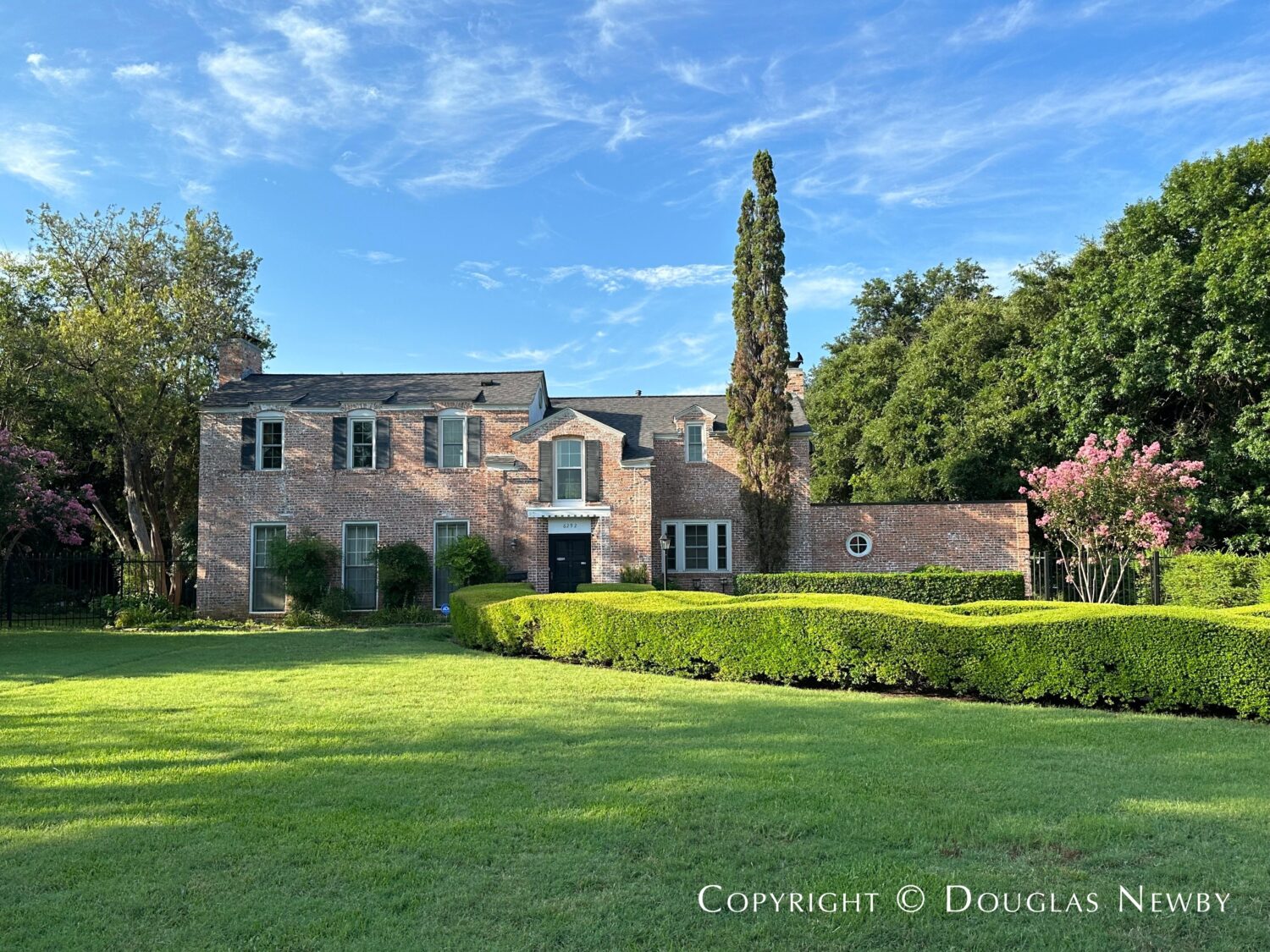
Preservation celebrates another preservation victory. I just sold one of the most important architecturally significant homes in Dallas with deed restrictions included in the sale that prevent the home from being torn down, and helped the property sell for a higher price than the appraised value.
David Williams-Designed Home Sold for Over Appraised Value and with Preservation Deed Restrictions
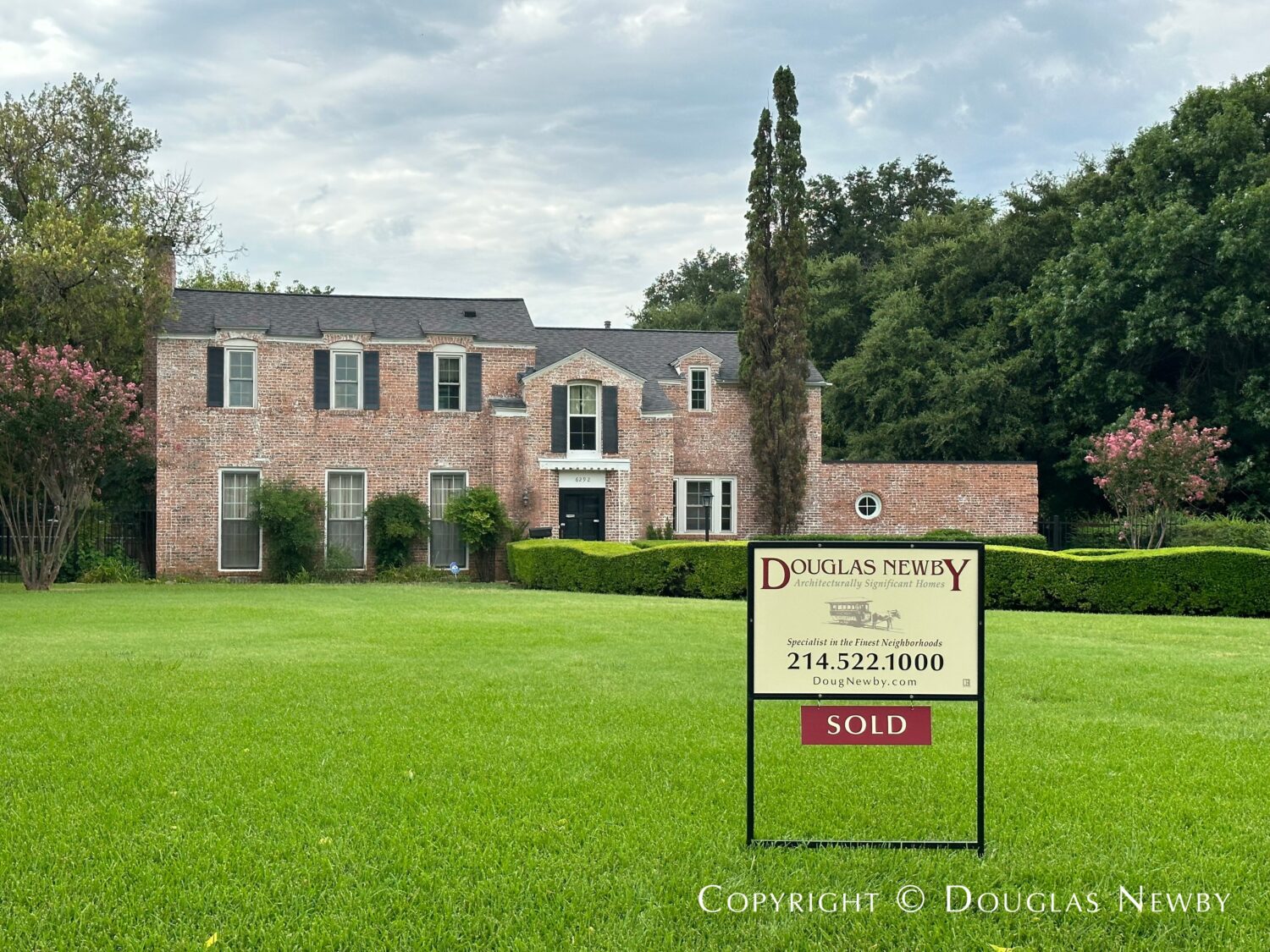
Most think preservation deed restrictions will depress the sales price of a home. I have consistently sold properties that had deed restrictions protecting the front facade of the home which prevents the home from being torn down for prices higher than the appraised values. This is the case with the David Williams architect-designed home at 6292 Mercedes Avenue in the Wilshire Heights neighborhood.
Preservation Deed Restrictions Weed Out Wholesale Lot Buyers and Allow the Focus to be on Buyers Who Love the Home
Lot buyers only need the dimensions of the lot to make a quick cash offer. This often preempts buyers who like the land and love the house, and who would pay more for the property than a lot buyer. Deed restrictions that protect elements of the home do not prevent renovation or even expansion. However, they do prevent a home from being torn down and often results in a higher price for the seller. The result is happy buyers who have an architecturally and historically significant home, and sellers who know their home will not be torn down.
Preservation Advocates and Builders Alike Thought 6292 Mercedes Would Be Torn Down

The David Williams architect-designed home is a classic case of appraisers, builders and even preservation advocates alike thinking the property would be sold at land value and the home torn down. The preservation of this David Williams architecturally significant home seemed unlikely to most.
A Small House on a Large Lot is Usually Considered a Teardown
This was the sentiment regarding 6292 Mercedes Avenue. A relatively small house at 2,600 square feet sited on a very desirable two-thirds of an acre lot is usually torn down. Making this house a teardown was an even greater possibility because the home was nearly 100 years old and it had no meaningful updates in almost 50 years.
This David Williams Designed Home – one of the Most Historic Homes in Dallas – Raised the Stakes for Preservation

The preservation of 6292 Mercedes Avenue was important not just because the home was almost 100 years old. This is one of the most important historic homes in Dallas. Its historic significance can be attributed to its architect, architecture, architectural significance, its lineage of prominent owners, and the impact of the home on the neighborhood, Dallas, and Texas.
Architect David Williams Set the Course for the Preservation of 6292 Mercedes Avenue
Little did architect David Williams know that when he designed 6292 Mercedes Avenue his design would save the home from being torn down 100 years later and become a victory for preservation. David Williams’ design of this home became the foundation of a Texas Modern architectural movement and a Texas design loved by the public.
David Williams’ Design Emphasized Architectural Integrity of Early Regional Precedence

Architect David R. Williams in the Southwest Review in 1931 wrote, “A logical regional architecture has for its origins the simple, easy forms of building native to its own locale, and grows by purely functional methods into an indigenous form of art.”
Architect David Williams is a Texas Icon Who Created the Texas Modern Style
Texas icon and architect David Williams created a style that was modern and had its architectural roots in pioneer Texas that became known as Texas Modern. His protégé, O’Neil Ford, became the face of Texas Modern architecture. Through O’Neil Ford’s work and subsequent architects, like his protégé, Frank Welch, O’Neil Ford influenced successive generations of Texas Modern architects.
Texas Modern is a Style as Modern as European Modernism but Rooted in Indigenous Texas

Architect David Williams deliberately created an architectural style that would be as modern as what the European Modernists were designing, and that would be authentically rooted in indigenous pre-1850 Texas pioneer homes. David Williams and Texas Modern style is to Texas what Frank Lloyd Wright and Prairie Style is to the Midwest.
Every David Williams Designed Home is Architecturally Significant and Preservation Should Be a Priority
Architect David Williams is so important, influential and talented that every one of the homes he designed is architecturally significant and deserves preservation. The preservation of 6292 Mercedes was critical for several reasons, including that it was the first home he designed in the Texas Modern style.
David Williams’ First Texas Modern Style Home was at 6292 Mercedes Avenue

The preservation of a home is easier when it has been reviewed and revered by historians and architecture critics for almost 100 years. In 1931, the Southwest Review did a series on Southwest architecture and the indigenous and regionally inspired homes designed by architect David Williams.
The 1927 Ray McDowell House at 6292 Mercedes is Always Credited as the First Texas Modern Home

The home David Williams designed for Ray McDowell is always credited as the first home David Williams designed in an indigenous Texas Modern style. His frontier artisan interiors and forms and architectural honesty are referenced in later publications. This approach reoccurs in his best-known work in 1933 for the home he designed for Elbert Williams at 3805 McFarlin Boulevard in University Park.
The Historic and Architectural Importance and Appeal of 6292 Mercedes Has Been Documented for Decades
Academic journals, home magazines, home tour brochures, SMU Magazine, and authors of architecture book have all discussed the importance and significance of the home architect David Williams designed at 6292 Mercedes and its impact on Texas architecture.
Muriel Quest (Mickey) McCarthy Writes Book, David Williams: Pioneer Architect
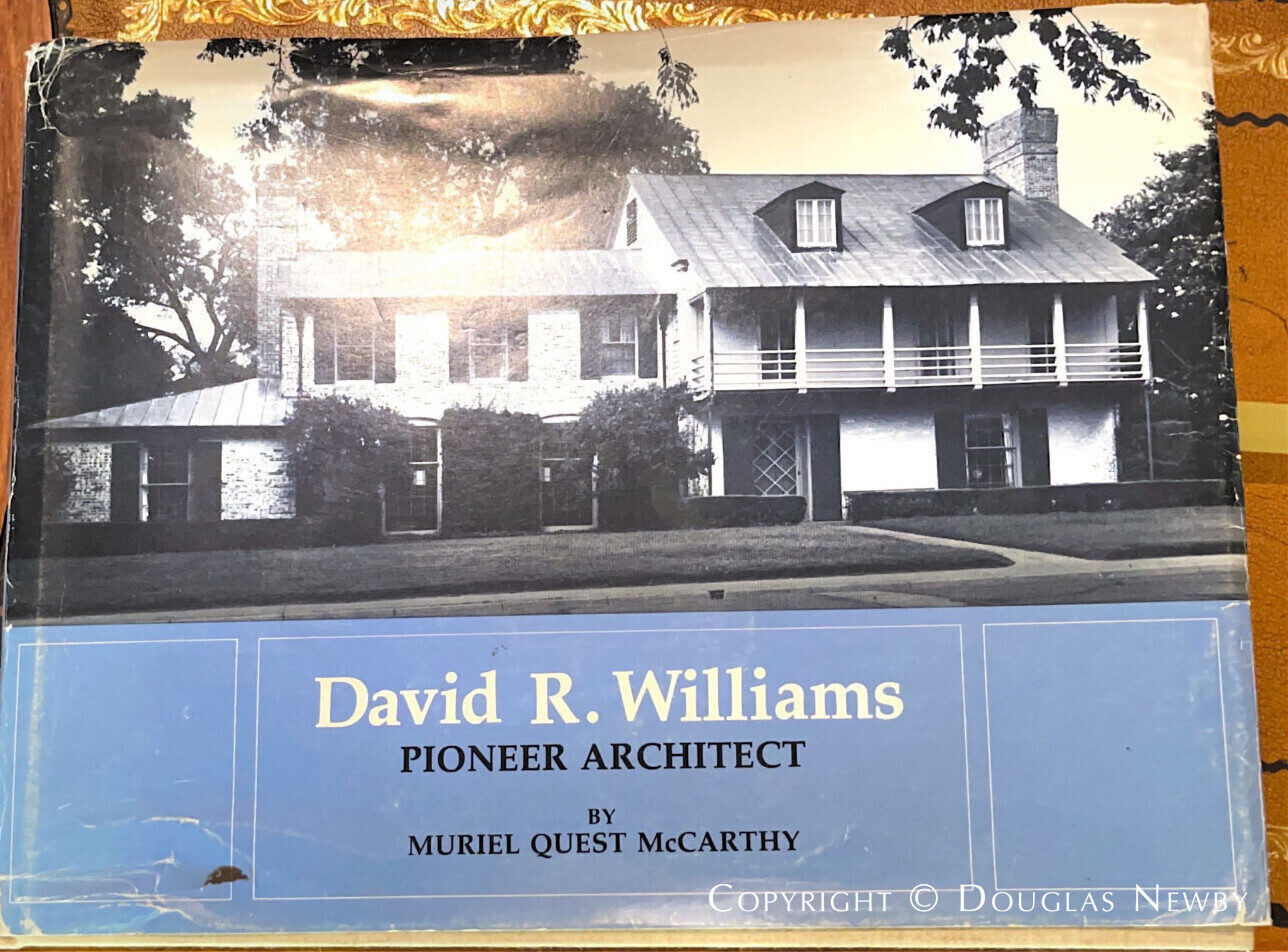
In the mid-1970s, very few books had been written about Dallas architects. Through SMU and the American Institute of Architects, a grant for research was provided, resulting in a marvelous book on architect David Williams written by Mickey McCarthy. McCarthy writes in her David Williams book that the Ray McDowell home on Mercedes was the first house built that incorporates indigenous Texas architectural concepts. She also cites in the Southwest Review in the 1933 spring issue, “The first attempt in the Texas style was the residence of Mr. Ray McDowell built in 1927.”
Texas Journal – of Ideas, History and Culture – Lauds David Williams
The Texas Journal article on Texas architecture, Mythologies and Realists, written by John Pastier, references David Williams’ regional manifesto in the 1928 Southwestern Architecture magazine. Here, David Williams notes the home he designed at 6292 Mercedes just a year earlier.
Architecture in Texas – 1895 to 1945 by Jay C. Henry Identifies 6292 Mercedes as First Texas Modern Home

Jay C. Henry, in 1993, wrote my favorite book on architecture. It gave me a better understanding of the homes I had been helping to preserve and the architectural links to the different Dallas neighborhoods. When Jay C. Henry discussed 6292 Mercedes as the first expression of Texas indigenous modern architecture, the whole concept of Texas Modern architecture was put into context for me regarding this 50-year period and beyond.
Dallas Architecture Can Be Divided into Eclectic, Modern, and Texas Modern
The Jay C. Henry Architecture in Texas book helped clarify in my mind that Dallas architecture could be fairly neatly divided into three categories: Eclectic, Modern and Texas Modern. The Texas Modern era started with 6292 Mercedes, making its preservation essential.
Dallas Chapter AIA 50 Significant Homes Recognized David Williams Home at 6292 Mercedes
For the 50th Anniversary of the Dallas Chapter AIA, I chaired the 50 Significant Homes project. This was the first informal citywide survey of significant homes in the city. The nominating committee consisted of the presidents of the leading cultural institutions and their selected nominators. The home David Williams designed at 6292 Mercedes Avenue was recognized for its significance.
Preservation Dallas Headlined Texas Regionalism Home Tour in 1999 with 6292 Mercedes Designed by David Williams
At the end of 1999, Preservation Dallas had its first Texas Regionalism Home Tour. This home tour discussed many homes and architects associated with Dallas and Texas. The highlight of the tour was the home of David and Carol Weber at 6292 Mercedes. A renewed interest in Texas Modern homes had taken hold.
D Home Identifies 6292 Mercedes in 2013 as One of the Ten Most Beautiful Homes in Dallas
The home architect David Williams designed at 6292 Mercedes was not only smart, it was beautiful. How many architects have 90 years of academic and architectural accolades for a home they designed? Even more remarkable, the same home is loved by the mass public as seen by this David Williams home featured at the top of the D Magazine list of Dallas beautiful homes.
O’Neil Ford Did the Working Drawings for 6292 Mercedes
David Williams claimed his greatest contribution to architecture was his protégé O’Neil Ford. While David Williams is the godfather of Texas Modernism, his protégé O’Neil Ford is the face of Texas Modernism and is celebrated across the state for his residences, sacred spaces and office buildings. Adding to the historic allure of the David Williams house on Mercedes was his protégé, architect O’Neil Ford, did the working drawings for the home. This is all the more reason why the preservation of this home is so important. The two most famous Texas architects worked on this Texas Modern home at 6292 Mercedes.
O’Neil Ford’s Handwritten Letter to Mr. and Mrs. Weber Reflecting on His Work on 6292 Mercedes


Dear Mr. and Mrs. Weber,
Yes, I did all the working drawings of your house (6292 Mercedes) when I was working for David Williams. – – Only one thing worries me – I cannot imagine that the house was built as early as 1926 – as that was the year I started working for Dave – Are you sure it wasn’t built in 1928? (Author’s note: The home was built in 1927) Later – in 1930 when I left Dave’s office (there being no work at all, I just put out my own shingle) and I did the house for Tammy and Steve Kahn, which must be next door to you or quite close by. (Author’s note: Actually this home is across Alderson Street, just a few doors down, and for several decades has been owned by former Dallas mayor Ron Kirk and his wife Matrice) … and tell you a funny story about Dave’s anger about some … cedars that the McDowells planted in front of the house – he removed them with a chain and a straight 8 Packard – !
Previous Prominent Owners Add Historic Significance and Further Call for Preservation of David Williams Designed Home at 6292 Mercedes
Many homes are considered historic not because of their architecture, but because of the prominent owners who once lived in the home. It is interesting that the home at 6292 Mercedes has so many reasons why it is historically significant, including its previous prominent owners. These prominent owners include: Ray McDowell, G. William Jones, David J. and Carol Weber.
David Williams Originally Designed the Home at 6292 Mercedes for Ray McDowell
David Williams designed the home at 6292 Mercedes for the first owner, Ray McDowell.
He was the real estate agent for the Abrams family when the Abrams were subdividing their land for homes. The Abrams retained 4.6 acres for their own home. This property is now owned by Stuart Crow and his wife. Ray McDowell and his wife selected the two-thirds of an acre lot at 6292 Mercedes across Alderson Street from the Abrams estate home.
G. William Jones, Second Owner, is Another Reason the Preservation of 6292 Mercedes is Warranted
If preservation is often determined by important people who lived in the home, G. William Jones qualifies for this distinction. William Jones was the founder of my favorite film festival – the USA Film Festival. In its early years at SMU, before there was a proliferation of film festivals, the greatest movie stars and film directors would mingle with festival-goers in the lobby of the SMU Meadows Fine Arts building before and after the films.
William Jones also founded the G. William Jones Film and Video Collection of SMU’s Hamon Arts Library. William Jones was an ideal owner of 6292 Mercedes because he spent his life proselytizing aesthetics and art when he lived in a home that was a piece of art.
David and Carol Weber Lived in David Williams Designed home at 6292 Mercedes Almost 50 Years

Carol Weber, an attorney, worked at SMU in the legal department almost her entire career. David J. Weber was arguably the most important southwest historian in the country. David J. Weber (1940-2010) was the SMU Robert and Nancy Dedman Chair of History from 1976-2010.
David Weber was an Academic Leader at SMU
David Weber was hugely respected by the faculty and students at SMU and his colleagues around the country. He was even able to convince esteemed historian William B. Taylor to become the Edmund and Louise Kahn Professor of History and Adjunct Professor of Anthropology at SMU. I first met Bill Taylor when I was a student at SMU and during a summer semester I joined prominent archeologists, anthropologists and art historians doing research and field work in Oaxaca. After so many years, it was a treat to see Bill and Barbara Taylor and to renew our friendship when he came to SMU.
David Weber’s greatest vision and accomplishment may not have been the definitive books he wrote on Southwest history, like his award-winning book, The Spanish Frontier in North America. His greatest accomplishment may have been his vision for the William P. Clements Center for Southwest Studies which was created through the generosity of William P. Clements Jr. Bill Clements served as chair of the board of trustees of SMU and also as governor of Texas. He had an immense personal library of books on Texas and the Southwest. He was passionate about the state of Texas and its history. David Weber and Bill Clements had a remarkable relationship. David came from a liberal academic background and Bill Clements was the first conservative Republican governor elected in Texas. David Weber always credited Bill Clements for both his generosity and commitment to Southwest studies and appreciated that Bill Clements never tried to influence the work or academic point of view of the Center.
Carol B. Weber and David J. Weber are Heroes for the Preservation of the Home David Williams Designed at 6292 Mercedes
The preservation of architecturally significant homes is way too rare an occurrence in Dallas and even more rare in other parts of the country. The preservation of this David Williams-designed home is due to Carol and David Weber’s insight and commitment to the preservation of a home they loved and their deep understanding the home was important for the history of the neighborhood, architecture, Dallas and Texas.
Carol and David Weber Loved 6292 Mercedes From the Beginning
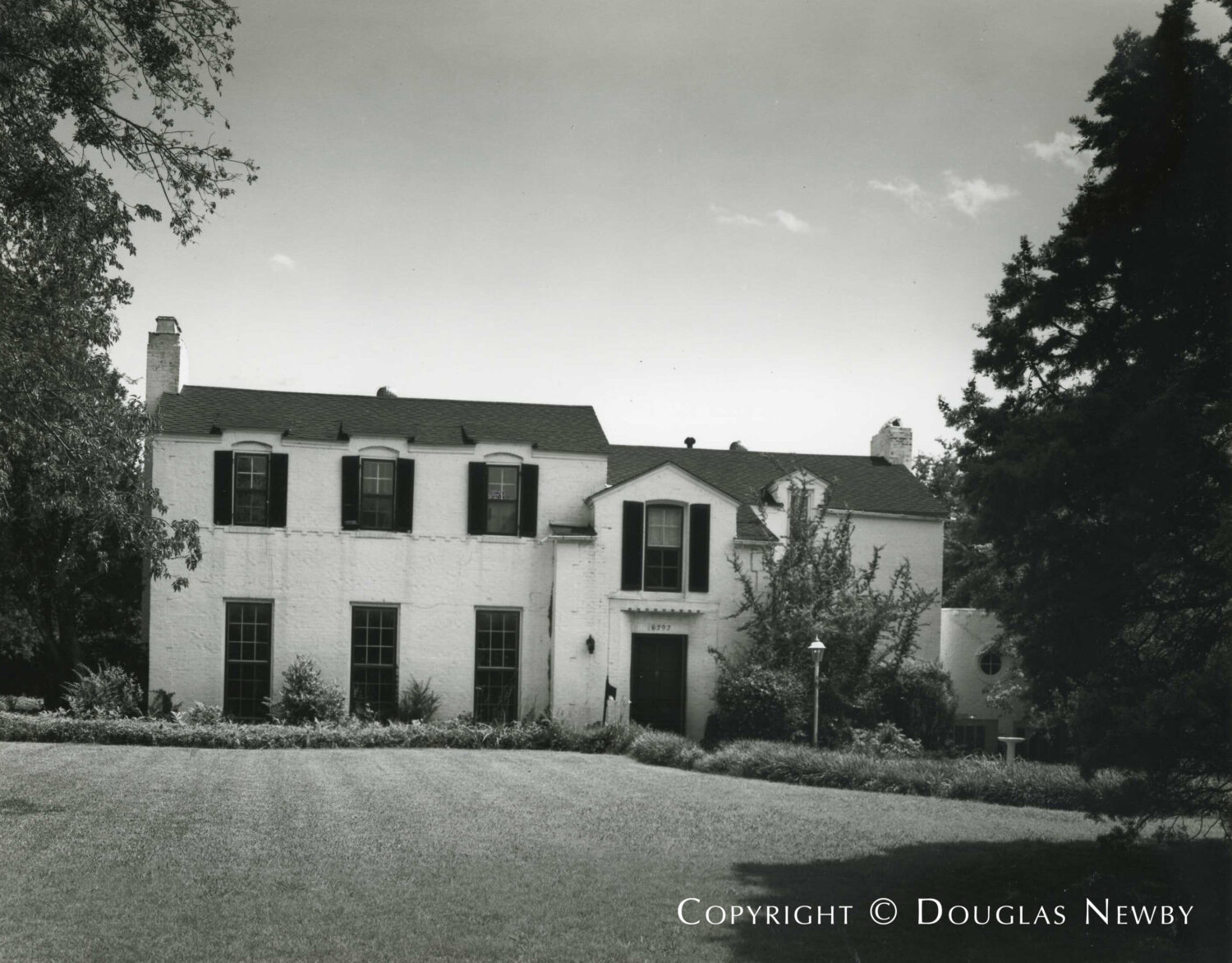
Well, almost from the beginning, Carol and David Weber loved this home at 6292 Mercedes. Upon first seeing the home, Carol thought the white painted brick had a bit of a plantation look. Her eye was good because even David Williams originally considered the general form of this style home to be Texas Colonial, and he was influenced by homes in East Texas and Louisiana, where he eventually moved.
Upon Entering the Home, Carol Weber Fell in Love with its Texas Authenticity
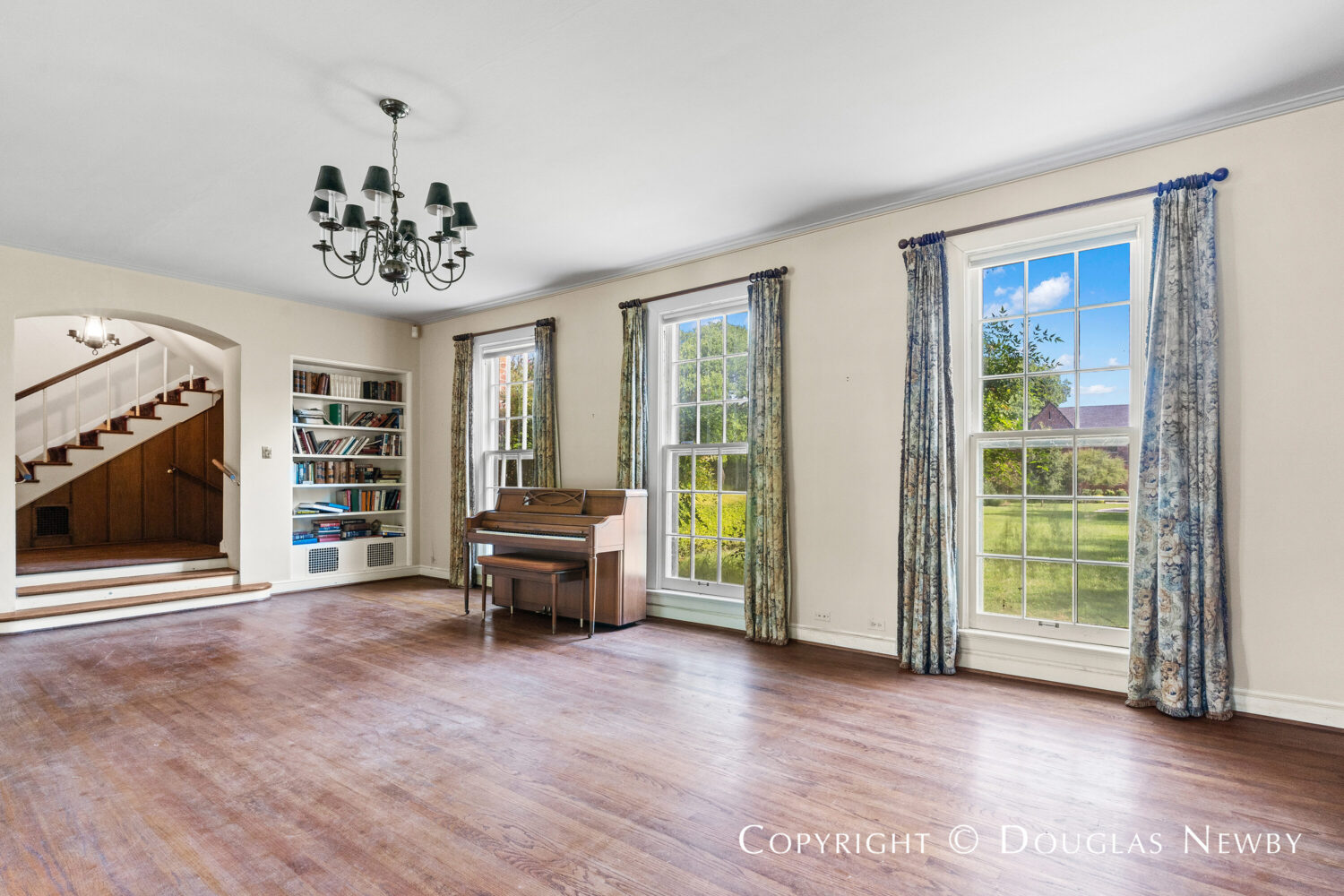
Once Carol Weber entered the home at 6292 Mercedes, she fell in love with the artisanship and authentic handcrafted detail in the home. She was thrilled with the nooks and crannies, bookshelves, windows, and the very open floor plan of connecting rooms with hardwood floors and wood details. Eventually, Carol and David Weber water-blasted the white paint on the exterior brick, which revealed the original used brick specified by architect David Williams.
David and Carol Weber Raised Their Children and Entertained in this David Williams Home

The preservation of a home starts with the love and admiration for a home. David and Carol Weber’s affection and appreciation for their David Williams-designed home grew over the decades. When they came to SMU in Dallas, they had left their home on two acres of orchards in San Diego and in Dallas desired a home with some land. The lot at 6292 Mercedes was one of the largest in Old East Dallas and it was flanked by two even larger lots in Wilshire Heights. The home itself could not have reflected better their aesthetic or love of the Southwest. Sleek modern might have great appeal, but it is harder to fall in love with a straight line than hand-carved detail and the warmth of craftsmanship which was rooted in Texas and found in the home.
History department parties and dinners were often held in the home as well as parties for their children’s friends and their parents. It is fun and rewarding when the reaction to one’s home is so consistently generous, genuine and positive. People loved this home designed by David Williams.
David Weber kept meticulous files on the house including articles and correspondence regarding the home, which is a treasure trove of valuable Dallas and architectural history. David and Carol donated these files to SMU’s DeGolyer Library.
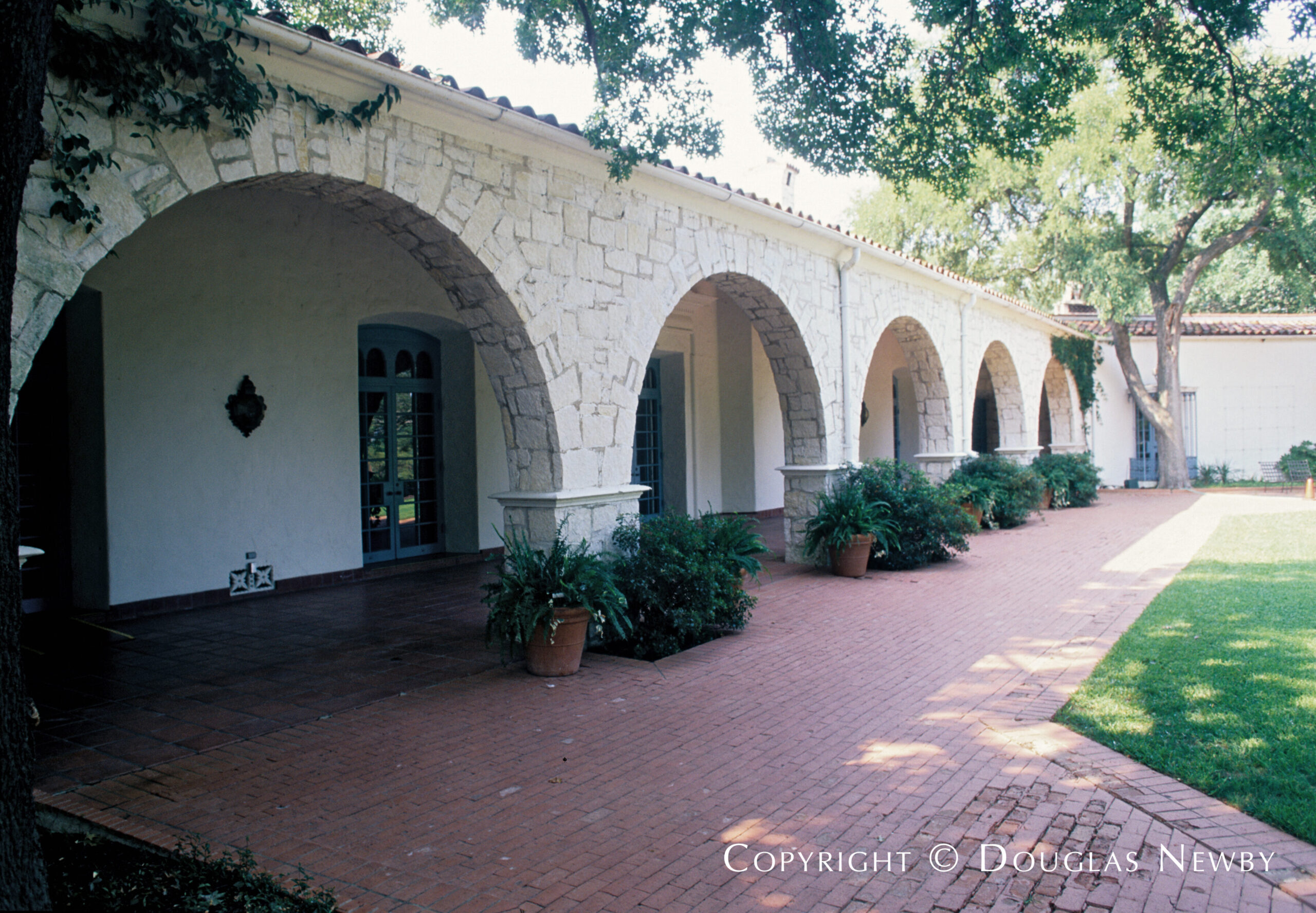
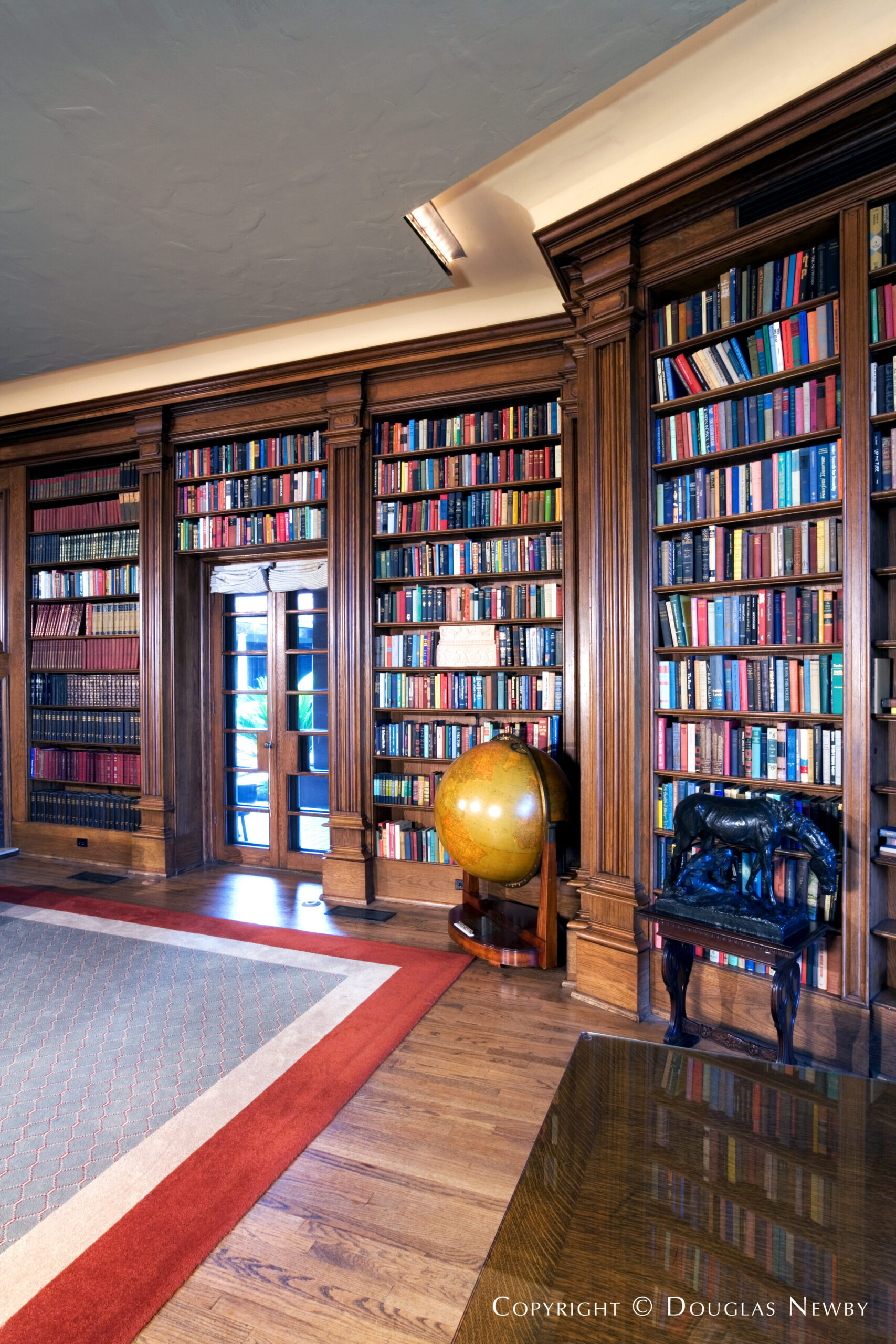
Preservation Success – David and Carol Weber Saved the First Texas Modern Home
I knew Carol and David Weber from the SMU Town and Gown Club where I served as President, from 1999-2000. This is an approximately 100-year-old club of about 50 gown members and 50 town members who rotate giving talks once a month during the school year. I also have had several SMU history professors as clients and mutual friends over the years. While I cannot recall how many years ago we discussed the preservation of their David Williams home, I do recall being invited to the Weber’s home to discuss the topic. David and Carol knew they would always live in the house as long as they were alive and able. However, I think they enjoyed living in the home even more knowing that there was a viable vehicle and plan that would make the preservation of their home possible when the time did come to sell it. We never talked about this preservation plan again until Carol called and said she might be moving to Colorado to be close to family.
I Was Touched and Honored to Represent the Weber Family in the Sale and Preservation of Their David Williams Home
We revisited the preservation plan of how Carol Weber placing a deed restriction on the front face of the home would, in effect, prevent it from being torn down. A $1 million penalty is in place if the front facade restrictions are violated. The home can still be renovated or expanded. The more money invested in the renovation or expansion of the home, the less likely that a future buyer would tear the house down.
The Preservation Plan was Executed and the Seller Received a Sales Price Higher than the Appraised Value

Just as the Webers and I had hoped, our preservation plan worked. Their David Williams designed home at 6292 Mercedes has a front facade deed restriction that prevents the home from being torn down, and the Webers received a price higher than what the home appraised for. We will all be able to enjoy the history and the architecture of this architecturally significant home for decades to come.
Thank you, Carol and David Weber!
Additional Thoughts by David Williams on Why Texas Modern Homes Were Better Than Their Eclectic Precedents
I thought it would be fun to conclude with a few biting thoughts from David Williams as he discusses Texas Modern style in relationship to the Eclectic style homes that were so prevalent.
Let us compare with this house one of the usual porchless ‘English type’
-David Williams
cottages of similar style which are so prevalent today in all of our cities and towns.
David Williams goes on to explain the desires of the common homeowner:
I want an English house about the same size. I want an English house with a fake chimney on the front for effect, veneered with stones an inch and a half thick (which seems solid until the corners are seen), with chimney pots, painted to look like terra cotta and an S chimney bracket that doesn’t brace anything, made also of tin. I must have wrought iron hinges made of sheet metal, which are not hinges at all; but must be nailed to the entrance doors which may be of pine but must look like walnut. I must have three gables in three sizes sticking up through the roof where there is no reason for a gable at all, and these gables must have fake half-timber made up of one by four scantlings which will warp the third day they are up. I want imitation shutters with no hinges and they must be nailed solidly to the wall, for I can’t stand shutters that rattle …


